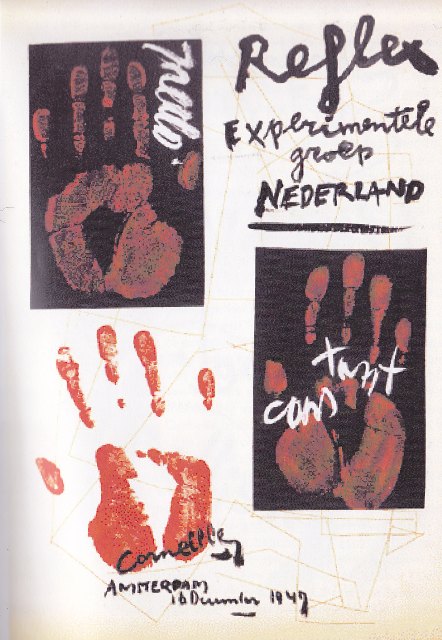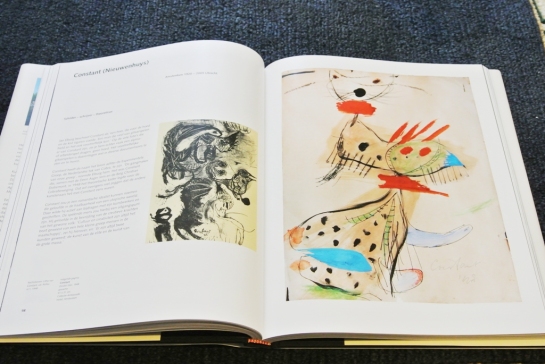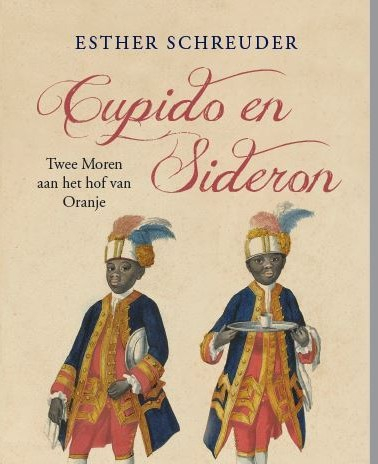Exhibitions in 2016:
1: Constant: Spelen met ruimte en kleur. Van 28 mei tot eind september 2016 in het Cobra Museum Amstelveen. 2: In Gemeente museum Den Haag: Constant: New Babylon.
Below my essay about Constant in CoBrA on the canal. The texts in the book are based on statements that the Cobra artists and writers did themselves about each other.

Constant, Collage, 1948. Collectie Ambassade Hotel, v/h collectie Hans en Alice de Jong
Constant (Nieuwenhuys)
Amsterdam 1920-2005 Utrecht
Jan Elburg described Constant as ‘a gentleman, who was fond of hats and boxes of cigars. A man who passionately loved playing the guitar and who did so superbly’. In the photographs of Constant that abound, however, you often see him wearing a beret or a working man’s flat cap, not a hat. On the other hand, his outstanding guitar playing can be seen and heard in various documentaries.

Constant was reputed to be the mastermind behind the Experimental Group, the Dutch offshoot of Cobra. ‘The
standard-bearer of our group’, was what Elburg called him.

It was Constant who, together with the Dane Asger Jorn, and the Belgian Christian Dotremont, laid the theoretical framework for the Cobra movement in 1948.

This does not mean, by the way, that the other artists were in agreement with Constant. Karel Appel and others wrote a contra manifests.
You could say that Constant was a romantic idealist who believed that it was possible to forge a better, utopian, world. He saw his art and writing as actively working towards that end. The playful human being would serve as a starting point. He believed in unleashing the creative powers of ordinary people. ‘Culture and creativity have always been the prerogative of a very small group of people in society’, he explained, and went on to say that, ‘there have always been two types of art; elitist art and the art of the masses.’
He preferred calling his work ‘revolutionary realism’. In other words, a reality viewed from the perspective of creating a better, more humane and freer society. He drew his inspiration from the avant-garde prior to World War II, from the international Dada movement and from 1930s surrealism.
The collage above from 1948, clearly shows how he was influenced by the cubist and Dada artists’ use of collages with found objects. Constant’s found objects in this case are torn scraps of newspaper. One of them shows an aerial photograph of Dam Square in Amsterdam. He gave Dam Square ‘Picasso horns’ and a tail in the shape of an eye.
Could it be a beast?

Another scrap of newspaper has arms, four legs and, seemingly, a face with two cubist ‘Picasso eyes’ next to each other. The third scrap of paper is from the obituaries. They have been given a colourful moustache. Is he trying to tell us something? For instance, that death heightens awareness of life?

Or: ‘Be not afraid to live life?’
Life history
Constant Nieuwenhuys was born into a Catholic family in Amsterdam in 1920. From an early age he showed great interest in literature, music and the visual arts.
His choice fell on the visual arts and he studied at the Royal Academy in Amsterdam from 1939-1940. His work was then still deeply religious, but not for much longer. He abandoned his faith and moved to the artists’ village of Bergen where he became affiliated with the group of artists known as De Nieuwe Kring. During the Second World War he lived alternately in Bergenand Amsterdam.
When the war ended he was able to travel outside the Netherlands in search of new stimuli. On a visit to Paris in 1946 he met Danish artist Asger Jorn, which made a deep impression and turned out to be of crucial importance. Danish artists had, for some time, been doing what Constant was still looking for: severing themselves from the old classical European aesthetic. Both Constant and the Danish artists believed that European art had reached an impasse. Jorn asked Constant if he would help put together an international group of artists, but Constant had to decline the offer because at that time he did not know any like-minded artists in Amsterdam. Two years on though, he met Karel Appel and Corneille and Constant was able to follow in the footsteps of the Danish experimental group Høst and set up the Dutch Experimental Group in December 1947.

The Dutch group grew and new members included Constant’s brother Jan Nieuwenhuys. Almost one year later in Paris, on 8 November 1948, like-minded artists from Belgium and Denmark (the Høst Group) merged and the international group was given the new name of Cobra. The members of the Dutch Experimental Group who were present when Cobra was founded in Paris travelled together afterwards to Denmark to join their Danish cohorts in a Høst exhibition.
The artists did not find it easy to work together and meetings, in particular, often became quite stormy. Jan Elburg gave a great example of how things went: There was feverish activity in 1949, including a lot of meetings. They were usually held at Constant’s house, in the front room with the round mahogany table and the rest of the antiques he had acquired from various people. Everything stood on the bare floorboards, in stark contrast with the brightly coloured wall paintings of masks and mythical creatures that adorned the entire house. It was here that poets Kouwenaar and Lucebert were supposed to recite ‘The beachcomber’ and ‘Eastern love’, respectively, but I don’t so much remember that as the explosive shouts from the painters when the ideas that were being discussed involved mutual competition. Constant tended to become apoplectic and desperate because, as far as motifs went, Karel Appel had the shamelessly irritating habit of copying him. ‘You’re copying my paintings,’ he raged stutteringly. ‘When I was painting bird’s claws and – beaks − a few months ago, you suddenly started painting bird’s claws and – beaks. Now I’m doing wheels and you suddenly paint wheels! Can’t you see that you’re copying me!’

An early piece by Constant in the hotel’s art collection somewhat illustrates what Constant meant about Appel. In the piece, the typical, colourful, rounded animal figures are shown stacked on top of each other. The cat and the bird are now regarded as characteristic of the ‘language of Cobra’.

Above work o by Constant belongs to the ‘Good Morning Rooster’ (Goedemorgen Haan) publication Constant jointly made with the poet Gerrit Kouwenaar in 1949. Kouwenaar reminisced later on that they complemented one another. He sometimes wrote the accompanying text to Constant’s drawing and sometimes it was Constant who added drawings to his texts. Constant had reproductions made of the works and then coloured them in by hand.
The bickering over Appel’s copycat tendencies did not lead to a split between Constant and Appel. However, relations between Constant and Jorn quickly became problematic. One of the reasons was because Jorn started an affair with Constant’s wife, Matie Domselaar.
Jan Elburg wrote the following: ‘After Constant and Asger Jorn had worked together in Denmark for a while, Constant returned to the Netherlands accompanied only by his young son Victor. His wife Matie chose to live with Jorn and stayed in the north with her two daughters. From that moment onwards, Victor, who was about six years old, became a sort of mascot for the group. French friends called little Victor ‘Totor’. Everywhere Constant went he took Victor with him, whether to meetings, private views or even press conferences.’
The Cobra group disbanded in 1951, after three years, because of the increasingly hectic lives of the artists.

Cover by Constant in a monography about Constant written by Christian Dotremont, 1950. Collectie Ambassade Hotel
Constant, accompanied by his son, had already gone to Paris with Karel Appel and Corneille to pursue their work further there. He returned to Amsterdam in 1952 and actively participated in various artists’ groups such as Liga Nieuwe Beelden (League of New Images) and the International Situationists. A key figure in the latter group was, once again, Asger Jorn. Constant had apparently forgiven Jorn. They picked up where they had left off and renewed their discussions.
Constant kept on reinventing himself. One of his most famous projects was the architectonic city New Babylon project, which he worked on for over twenty years. The project was exhibited all around the world.
In 1964 Constant published a remarkable essay entitled ‘The rise and fall of the avant-garde’. He contended that the real avant-garde had only existed between the two world wars and not after 1945. This latter period had been a quasi-neo type of avant-garde, in his opinion. He took up painting again and started studying the great masters of the past, incorporating what he had discovered into his etchings and paintings. One of the pieces in the Ambassade Hotel derives from this period of time. It seems to depict a classical South European drama.

Constant’s work is included in the collections of the Stedelijk Museum Amsterdam, Stedelijk Museum Schiedam, the Cobra Museum in Amstelveen and in countless international museums, such as MoMA in New York, Centre Pompidou in Paris and Tate Modern in London.
Constant died in Utrecht in 2009.
Esther Schreuder Text from the book : Cobra on the canal (2013) about the Cobra collection in the Ambassade Hotel in Amsterdam. copyrights are paid by the publisher Samsara. Translation: Vivien Cook
See Huffington Post for review Cobra on the Canal
http://www.huffingtonpost.com/david-galenson/cobra-on-the-canal_b_4532441.html
All photos on this site are not intended for any commercial purpose. I have tried to trace all the rules and rights of all images. As far as I know, these images can be used in this way. If you ar a copyright holder and would like a piece of your work removed or the creditline changed then please do not hesitate to contact me.
estherschreuderwebsite@gmail.com
About me
In 2008 I was guest curator of the exhibition Black is beautiful. Rubens to Dumas. Important advisors: Elizabeth McGrath (Rubens and colleagues, Warburg institute Image of the Black in Western Art collection), Carl Haarnack (slavery in books), Elmer Kolfin (slavery in prints and paintings) en Adi Martis (contemporary art). Gary Schwartz made his research for The Image of the Black in Western Art available to me.

In 2013 my book Cobra aan de gracht / Cobra on the Canal, ( CoBrA artists in a private collection) was published by Samsara publications.

In 2014 my essay ‘Painted Blacks and Radical Imagery in the Netherlands (1900-1940)’ was published in The Image of the Black in Western Art Volume V (I). (ed. David Bindman, Henry Louis Gates jr.)

In 2017 I published a book about the black servants at the Court of the Royal Van Oranje family. More than a thousand documents have been found about their lives. (only in Dutch)

All photos on this site are not intended for any commercial purpose. I have tried to trace all the rules and rights of all images. As far as I know, these images can be used in this way. If you ar a copyright holder and would like a piece of your work removed or the creditline changed then please do not hesitate to contact me.
estherschreuderwebsite@gmail.com
